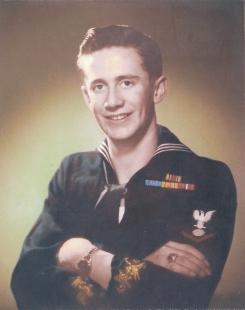Herluf Christensen
Era: World War II
Military Branch: Navy


Mr. Christensen served in World War II in the Pacific Theater and was a participant in the Okinawa and Philippine campaigns.
He entered the U.S. Navy Reserve in July 1944.. He was assigned to the light cruisers USS Mobile (CL 63), USS Springfield (CL 66) and USS Astoria (CL 90).
His rank was Electrician's Mate 3rd Class.
Mr. Christensen was decorated with the American Theater Medal, Asiatic-Pacific Medal, Philippine Liberation Medal, and the Army of Occupation – Japan Medal.
He was honorably discharged June 22, 1946.
Source: Hometown Heroes: The Saint Louis County World War II Project, page 56.
=======================================================
Mr. Christensen was born in 1926 to Pedar and Meta Christensen in Aarkhus, Denmark.
Source: Veterans’ Memorial Hall History Form; veteran’s account (see below)
Enlisted in the Navy - June/August 1944 - Boot camp, Farragut, Idaho
Aug/Dec 1944 - Electrician School - Seattle, WA
Jan. 1945 - to San Francisco and overseas to the South Pacific Feb/March/April/ 1945 Philippines - to USS Mobile (CL 63) in Okinawa.
Escorted some of the Fleet for several months.
Sept. War is over. The USS Mobile was the first ship to go in to Nagasaki (6 weeks after the atomic bomb was dropped) to pick up prisoners who had been there for several years —most of whom had been in the “death march.” We transported 2,500 of these war prisoners back to Okinawa for medical treatment.
In Oct. we rode out a typhoon.
In Nov. we left Okinawa and went to Sesabo, Japan. I was transferred from the USS Mobile to the USS Springfield (CL 66).
In Dec. we went to China, Korea, Russia and then back to Japan.
Jan 1946 - Left Japan to home (About time!)
-----
I enlisted in the Navy my senior year of high school in 1944 and had my physical in the spring of ’44 with fifty-four enlistees. It was the largest group, at the time, from Duluth. Fifty were sent to the Great Lakes camp and four (including me) were sent to boot camp in Farragut, Idaho. I was assigned to OGU [out-going unit] school but got scarlet fever and was hospitalized and as a result missed most of the assigned classes.
After boot camp I was transferred to Lake Union in Seattle, Washington, and attended electrician school for 16 weeks. After school I went home on leave, returned to Treasure Island in San Francisco, from where I left a troop transport in February of 1945 en route to the Philippines via a southern route. While en route, we suddenly stopped for approximately 15 minutes and suddenly a submarine (American) surfaced to check us out. I was stationed in the Philippines for about one month awaiting orders. We were then sent to Okinawa and assigned to the U.S.S. Mobile. At one point we left the harbor to ride out a typhoon and then returned to Okinawa. We took part in the battle of Okinawa. Our ship missed taking two torpedoes: one blew up before it reached us, and the other went under the ship. After the Okinawa battle we did “hit & runs,” protecting aircraft carriers in the fleet.
After the war was over in August, and six weeks after the atomic bomb was dropped on Nagasaki, we were the lead ship (of three) from Okinawa to Nagasaki recovering prisoners of war from Nagasaki, taking them back to Okinawa. The U.S.S. Mobile made two trips, taking 500 prisoners each trip. The prisoners were mostly British. Most of them had been in the Death March and had been prisoners of the Japanese, working in the coal mines for over three years. They weren’t sure if their families even knew that they were alive. Many of these men were brought out on stretchers; some were able to walk. Back on our ship, we gave these men access to our bunks and changes of clothing—most of them were barefoot and had “rags” in the form of clothing.
From Okinawa, the Mobile was sent to Sasebo, Japan, where I was transferred to the U.S.S. Springfield. While on the Springfield, we sailed to Shanghai, up the Yangtzi River to Tsingtao, then to North Korea via the Russian border and back to Sasebo.
In January 1945, we headed back to the States, to Long Beach, California. I returned to Long Beach after my trip home (leave). After two months, I was transferred to the U.S.S. Astoria and sent to Astoria, Washington. We escorted the Rose Festival queen and her court up the Columbia River to Portland, Oregon. While in Portland, I received my 2nd class rating, but opted to come home for discharge in June 1946.
While being processed for discharge I met a friend that I had enlisted with but had lost contact with during my time of serve. Quite a coincidence.

